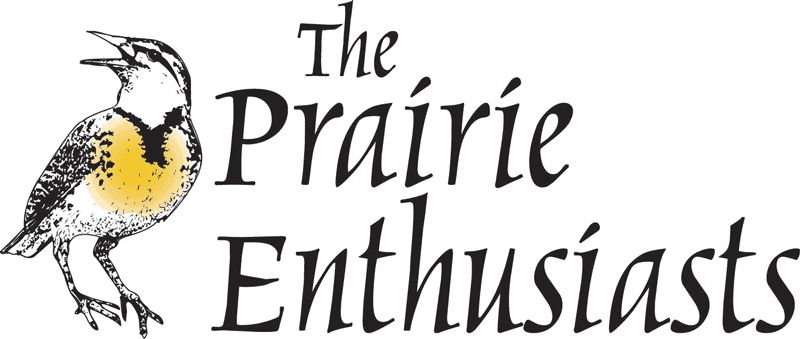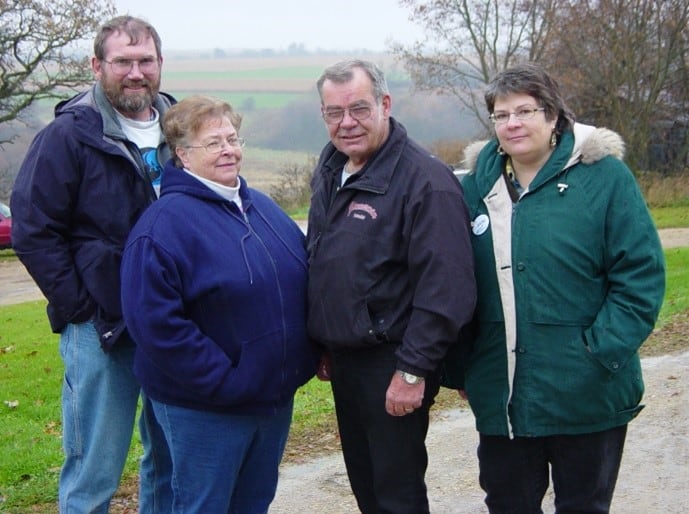
Shea Prairie
The 103-acre Shea Prairie Preserve is located within the dissected, un-glaciated landscape of southwest WI. It lies within what was once a large prairie that extended north to the Military Ridge, covering many thousands of acres. The preserve is within the 50,000-acre Military Ridge Prairie Heritage Area (MRPHA).
The MRPHA has been identified as one of the best opportunities in Wisconsin for prairie/grassland conservation on a landscape scale. In addition to grassland bird use of the area, there are three state-listed plant species at the site: prairie turnip (Pediomelum esculentum), Richardson’s sedge (Carex richardsonii), and Hill’s thistle (Cirsium pumilum).
ACCESS & DIRECTIONS
In Brigham Township, Iowa County, Wisconsin (T6N, R5E, Section 26, W 1/2 of SW ¼). The preserve lies along the east side of Mounds View Road, ¾ miles south from the intersection of Mounds View and Prairie Grove Road. Address is: 3095 Mounds View Road, Barneveld.
Google Map
Description & Significance
Of the 103 acres, it currently has 7 acres of good quality dry & dry-mesic remnant prairie, 6 acres of unplowed mesic prairie sod over-grown by trees & brush and severely degraded by grazing, 11 acres of cold water trout stream and stream bank habitat, 2 acres of degraded spring seeps, ephemeral pond, and organic (peat/muck) wet soil, and lastly 36 acres of Federal Conservation Reserve Program (CRP) grassland.
At the time of the original land survey in 1832, the preserve was entirely prairie, including sedge meadow in the wettest areas. The property is traversed from north to south by William’s Creek, and there are several areas of ground water discharge (seeps), including a small ephemeral pond, where the valley floor meets the uplands. In the SE corner of the preserve, the land rises quickly to over 100 ft above the valley bottom. This high ground is where the prairie sod is located. The substrate is composed of Platteville and Galena dolomites, with a band of St. Peter’s sandstone near the base of the slope. The latter formation is exposed at the surface in places. The soils across the Property are predominantly silty to silt loam in texture. There is a layer of thin silt loam on the high ground and deep (> 4 ft thick) silty alluvium in the valley bottom. There is a deposit of wet organic (peat/muck) soil east of the stream that is approximately 2 acres in size.
The preserve is significance for its remnant prairie vegetation and associated rare insects, and as wildlife habitat at both local and state levels. In fact, it may play a critical role in prairie ecosystem conservation in Wisconsin, for it lies within the 50,000-acre Military Ridge Prairie Heritage Area (MRPHA). The MRPHA has been identified by the Wisconsin Department of Natural Resources (DNR) as one of the best opportunities in the state for prairie/grassland conservation on a landscape scale. Due to the area’s importance, there is a formal partnership of over a dozen public and private conservation organizations and agencies focusing resources into the MRPHA in an attempt to maintain and restore prairie and grassland habitat within a matrix of working farmland. The MRPHA currently supports critical habitat for many grassland dependent birds such as western meadowlarks, grasshopper sparrows, Henslow sparrows, dickcissels, bobolinks, northern harriers, and upland sandpipers that have been in decline in recent decades, . It is also home to a major concentration of the state-endangered regal fritillary butterfly (Speyeria idalia) which requires large tracts of prairie sod, as well as many other rare and endangered prairie insects and plants.
Specifically, the Shea Prairie is part of a sub area within the MRPHA called the Mounds View Prairie Complex, which is one of the three most significant concentrations of prairie sod and grassland bird habitat within the MRPHA. The Shea Prairie Preserve is immediately adjacent to, or within 1/4 mile of, important tracts of high quality prairie remnants with rare and declining species and extensive acres of grasslands enrolled in CRP. The property connects to the 276-acre A to Z tract which was recently protected by TNC, and is soon to be transferred to TPE for management. With continued restoration and management, the Shea Prairie’s 62 acres will provide important habitat for many area-sensitive grassland birds and other rare and declining prairie species.
Much of the high ground in the SE corner of the property is too rocky and thin-soiled to have been tilled. Thus, it supports original unplowed prairie sod which ranges from dry to mesic in soil moisture on W and NW facing aspects. The remnant sod is in varying stages of degradation due to both brush/tree invasion in recent decades and past livestock grazing. However, grazing has been absent for at least 32 years, and approximately half the prairie sod (the drier half of the moist spectrum) has rebounded to a state of moderate to good quality prairie vegetation. In the past few years, the recovery has been accelerated by active management through a management. The remainder of the original unplowed prairie sod is dry-mesic to mesic in nature, and is extremely degraded by heavy tree/brush invasion and past grazing. The most level portion of this area may have been plowed a long time ago, but there is no cleared evidence of old plow lines to confirm this.
Based on original land survey records and current conditions, the entire bottomland of the preserve was likely mesic to wet prairie with pockets of sedge meadow at the time of settlement. Most of it is retired cropland, seeded in brome, that has been enrolled in the CRP. The stream running through the property supports trout and is of very good water quality according to a Biotic Index based on stream invertebrates collected by the DNR. It has areas of sand and gravel bottom, and rock riffles, with natural oxbows present. There is some very limited native wet prairie and sedge meadow vegetation along parts of the stream and in a few of the wettest pockets away from the stream. Some of these pockets have organic soil, with native wetland vegetation starting to reestablish, and a small ephemeral pond with breeding frogs (chorus frogs, spring peepers, Cope’s gray treefrogs, and toads) in the spring. Willow and other tree invasion has been occurring along the stream over the past 50 or more years. Along the east edge of the lowland where it meets the uplands, there is a small area of raised peat that appears to have been a perched a fen. Now, it is overgrown with boxelder and is beginning to oxidize. Some bluejoint grass, Jacob’s ladder, and a few other fen associates are still evident, but extremely limited. There is another small groundwater discharge area near the base of the north end of the prairie remnant hill, with sedges and other wet meadow species reestablishing. The entire bottomland area has great potential as grassland bird habitat, and, with prairie restoration, it will eventually provide critical refuge for the state-endangered regal fritillary butterflies during dry years. The property’s cold water stream and spring/seep wetland areas are significant for the MRPHA, for they provide important habitat diversity to this generally dry upland landscape.
Thorough biological surveys of the property have yet to be done, but some information is available. Birds observed at the site include the State-Threatened Bell’s vireo and various other grass & brush land species such as woodcock, eastern meadowlark, grasshopper sparrow, sedge wren, field sparrow, brown thrasher, willow flycatcher, clay-colored sparrow, and the Northern shrike. Three state-listed plant species have been found: prairie turnip, Richardson’s sedge, and Hill’s thistle. There are strong displays of rough blazingstar, hoary puccoon, shooting star, and cream Baptisia on the better remnant sod. The state-threatened regal fritillary butterfly moved onto the property two years ago, from adjacent land, as trees and brush were removed and fire reintroduced.
Ownership History
The Shea Prairie was dedicated during a ceremony on October 28, 2006. Attending the dedication were land owners Diane and John Shea (pictured center), TPE Vice President Rich Henderson (left), and TPE Executive Director Renae Mitchell (right).
Bordner’s 1936 Land Use Economic Inventory listed the upland prairie areas of the Shea Prairie Preserve as pasture and the lowlands as a combination of pasture and cleared cropland. John and Diane Shea moved on to the farm in 1974, but they never pastured the prairies. They grew crops in the bottomlands along William’s Creek until enrolling the fields in the Conservation Reserve Program in 1998. The non-cropland portions of the bottomland were burned once sometime in the 1980’s. The remnant prairie was not burned during their ownership.
In the mid 1990s, Rich Henderson, while gathering information for a DNR study on landscape-scale management opportunities in WI for grasslands and savanna ecosystems, identified the Shea property as likely having remnant prairie. The ID was made using aerial photos and long-distance observation across the valley. In June 2000, Scott Sauer and Eric Maurer, working on a DNR Prairie Insect Inventory Project, visited the site with owner’s permission. They appear to have been the first ecologists to visit the Shea Prairie. In 2003, Kristin Westad, as the field coordinator of the newly established MRPHA Project, contacted the Sheas to inform them of the biological importance of the Project area and the significance of their property within it. At about the same time, Amy Staffen, working for TPE on land management projects and in coordination with Kristin, contacted the Sheas to see if they would be interested in entering into an agreement to allow management/restoration of their prairie remnant. They were very receptive, and entered into an informal agreement with TPE, and eventual an agreement with the U.S. Fish & Wildlife Service (FWS) as well.
In the spring of 2004, Kristin Westad (representing TPE) and Derek Johnson (with TNC) meet with the Sheas to explore the possibility of permanent protection of their prairie. The Sheas were very supportive of the idea. TNC (starting with Derek and ending with Rodney Walter) and TPE (Rich Henderson) continued discussions with the Sheas that culminated with 62 acres becoming a TPE Preserve on August 18, 2006. Protection of this site was made possible by a grant from the Knowles-Nelson State Stewardship Fund, donations to TPE from Pheasants Forever Dane & Iowa County Chapters and several private individuals, help and guidance from TNC, and of course the support and cooperation of the Shea family. We are very grateful to them all.
Management
Half of the open prairie sod was burned on April 13, 2004, by TPE volunteers. From April-August, 2004, contractors were hired by TPE, paid for by a U.S. Fish & Wildlife Service (FWS) grant, to clear trees from the best prairie areas. They also pulled/dug/cut parsnip and sweet clover in the prairies during June-August. TPE volunteers continued with parsnip and sweet clover control, and tree/brush removal on the prairie remnants, in 2004 & 2005. In the winter of 2005&06, 2/3 of the trees along the stream were removed by contractors under agreement with FWS Private Lands Program.
Even with the significant work that has been done, the Shea Prairie Preserve is still very much a work in progress, but one with great potential for making a major contribution to both short and long-term prairie ecosystem conservation in WI. At least 2/3 of the tree and brush removal still remains, invasive weeds are not yet fully under control (including some serious patches of reed canary-grass), many acres need to be planted to prairie, and there are wetlands to restore and a cold water stream to improve. There are also improvements needed to facilitate limited public use that comes with state grants and good neighbor relations, improvements such as a parking lot, a kiosk, and posting of property boundaries. With the help of on going and additional land management grants and the dedication of our many TPE volunteers, we are confident in reaching our goal of restoring a rich and diverse prairie ecosystem that ranges from wet to dry.


